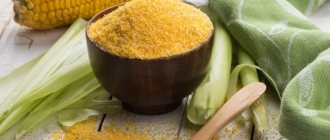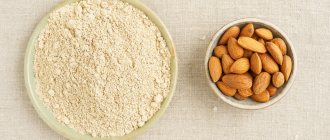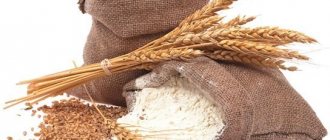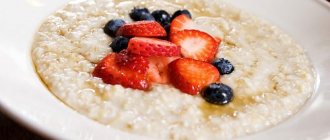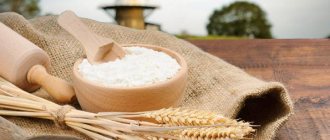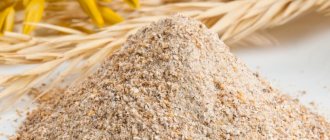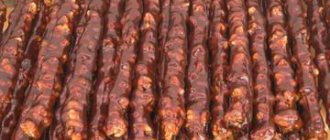Types of rye flour
The type of flour is selected depending on the type of baked goods being prepared. Several types of substances are used, the properties, benefits and harms of which differ:
| Type of flour | Properties | Notes |
| Peklevannaya | Very fine grinding, used for gingerbread, light cream bread, and pies. | Due to intensive processing, the composition contains few vitamins and other valuable substances. |
| Seeded | Used in its pure form, without impurities, it makes good homemade baked goods. | Low calorie content, products are recommended for diabetics and during diets. |
| Ripped off | Low nutritional value and gluten content, only for bread. | When making homemade bread, you need to include some wheat flour among the ingredients. |
| Wallpaper | Very coarse grinding, the characteristics of unprocessed cereals are fully preserved. | In terms of benefits it surpasses buckwheat and barley flour. |
The properties of wallpaper flour make it an excellent way to combat constipation, atherosclerosis, and high cholesterol without medications. The benefits of raw materials lie not only in their rich composition, but also in the abundance of fiber. Peeled rye flour is beneficial for weakened hair.
The benefits of rye flour

Rye, like the flour obtained from it, can be used not only for culinary, but also for medicinal purposes. The substances contained in it help remove waste, toxins and metal salts from the body, thereby improving the human condition and helping the body fight many diseases. When consumed regularly, rye flour stimulates the immune system, increases the body's ability to resist disease, normalizes the hormonal system and improves the quality of antibody production.
One of the clear advantages of rye flour is the fact that if you choose whole grain varieties, then the dough made from it can rise when using ordinary sourdough, without yeast. In addition, unrefined flour gives a very special taste to baked goods, while it has a very low calorie content and is ideal for a healthy diet. A wide range of essential amino acids, that is, those amino acids that our body cannot produce and must be obtained from the outside, makes products made from rye flour an ideal candidate for inclusion in the menu of diabetics.
Due to its absorbent function, rye flour, entering the intestines, is able to cleanse its walls and helps the body remove excess substances. As a result, the condition of the intestines improves and immunity increases.
Baking from rye flour will be very useful for those people who live in areas where there is little sunlight. In addition, it is very useful for those suffering from anemia or those people who clearly have a metabolic disorder. However, if you suffer from high stomach acidity or ulcers, it is best to avoid rye flour products.
Chemical composition of rye flour

The beneficial composition of the raw materials provides the body with the following minerals:
- Phosphorus – maintains healthy cartilage and bones.
- Magnesium, iron - help the body in normal hematopoiesis.
- Potassium – timely transmission of nerve impulses.
- Calcium – high-quality activity of the nervous system, strong skeleton.
The raw materials are rich in macro- and microelements, vitamins B and E, useful for the cardiovascular system, the thyroid gland, and the treatment of anemia. It does not cause harm, it only guarantees good health.
Properties of rye flour
This is a product obtained from rye grains by grinding it. It is available in the following types:
- peeling;
- seeded;
- wallpaper;
- pecked;
- whole grain.
Peeled rye baking flour has a grayish-cream color, no less than 90% of the endosperm and mealy kernel and no more than 10% of the outer shells of the grains. It is considered second in its nutritional properties - it has 298 calories. It is worth noting that rye flour brings both benefits and harm to the human body.
Vitamin and mineral composition

Experts have proven that the benefits of flour lie in the content of vitamins B, A and E, and minerals - potassium, iron, phosphorus, iodine, magnesium, zinc, copper and aluminum. The high fiber content helps normalize the gastrointestinal tract, gently removing toxins from the body. And regular consumption of bread made from peeled rye flour has a beneficial effect on the human reproductive system.
Despite all the beneficial properties, this product should not be eaten by patients with peptic ulcers or with high acidity in the stomach. When choosing a product of this type, it is important to pay attention to its color: the darker the product, the more useful bran it contains!
Whole grain product
This is a product of one-time grinding of grains. The following types of whole grain flour are distinguished:
- pea;
- buckwheat;
- rye;
- oatmeal;
- barley;
- wheat
Whole grain flour - benefits and harm for the body: the product is valued for its high fiber content, vitamins B and E, as well as a wide variety of macroelements - calcium, chromium, selenium, iron and potassium. That is why bread and other baked goods made from whole grain flour have a beneficial effect on the functioning of the heart, gastrointestinal tract, help maintain blood sugar levels and promote rapid weight loss.
It is very important to understand that the abuse of whole grain flour products is not beneficial, but causes profound harm to the human body. In addition, this product is contraindicated in acute diseases of the liver and stomach.
Whole wheat flour is quite easy to make at home. To do this, you can use one of the following methods:
First method: to the first or highest grade product, you must add bran in a ratio of 10:1;
Second method : whole grains must be ground in a food processor or coffee grinder.
Nutritional value and calorie content of rye flour
A standard 100 g contains carbohydrates (61.8 g), proteins (8.9 g) and fats (1.7 g). Total calorie content from 298 kcal to 305 kcal. This is less than that of a wheat product, so it is rye flour that will benefit weight loss.
The energy value depends on the growing conditions, the type of planting material and the degree of processing. A good percentage of useful components allows us to classify products, especially those made from wholemeal flour, as dietary food.
Advice! When preparing homemade rye kvass, you can infuse it exclusively in glass containers. This will prevent harmful impurities from getting into the drink.
Composition of rye flour
The lysine contained in flour is necessary for our body to ensure normal metabolism. Rye flour itself is considered one of the best sources of complex carbohydrates in the world.
It contains many minerals and elements that our body needs to maintain normal functioning. In particular, these are:
- calcium, necessary for teeth and bones;
- potassium, which maintains the nervous system in a normal state;
- magnesium and iron, whose task is to maintain the normal system of creating new blood cells;
- Phosphorus, which is essential for mental performance, supports bones and cartilage.
Chemical composition of rye flour (per 100 g)
| Calorie content | 298 kcal |
| Squirrels | 8.9 g |
| Fats | 1.7 g |
| Carbohydrates | 61.8 g |
| Alimentary fiber | 12.4 g |
| Ash | 1.2 g |
| Water | 14 g |
| Starch | 60.7 g |
| Saccharides | 0.9 g |
| Polyunsaturated fatty acids | 1 g |
| Saturated fatty acids | 0.2 g |
| Vitamins | |
| 0.35 mg | |
| 50 mcg | |
| 0.13 mg | |
| 0.25 mg | |
| 1.9 mg | |
| 1 mg | |
| PP (NE) | 2.8 mg |
| 3 mcg | |
| Minerals | |
| Iron | 3.5 mg |
| Copper | 230 mg |
| Aluminum | 270 mcg |
| Manganese | 1.34 mg |
| Zinc | 1.23 mg |
| Sulfur | 68 mg |
| Iodine | 3.9 mcg |
| Calcium | 34 mg |
| Fluorine | 38 mcg |
| Magnesium | 60 mg |
| Molybdenum | 6.4 mcg |
| Sodium | 2 mg |
| Phosphorus | 189 mg |
| Potassium | 350 mg |
All these substances are contained not only in rye flour, but also in products made from it, as well as B vitamins and vitamin E. The vitamin B1 contained in it is designed to maintain normal metabolism and improve the condition of the nervous system. Vitamin B2 is indispensable for the normal functioning of the reproductive system, good condition of the thyroid gland, and vitamin B9 is responsible for cell renewal and the creation of new blood cells, which prevents anemia.
In addition, rye flour contains much more protein and a higher concentration of vitamins than its wheat counterpart. But despite this, it is still not very popular due to the labor-intensive process of creating beautiful and tasty baked goods.
The benefits of rye flour for the body

Among the many beneficial properties of rye flour is the ability to influence the renewal of body tissues at the cellular level. Raw materials strengthen blood vessels, improve peristalsis without harm to the digestive system, and have a positive effect on the immune system.
For men
Men should take advantage of the beneficial properties of rye flour. Especially middle and old age. It is a source of plant phytoestrogens, which reduce the risk of prostate cancer, and if the problem has already arisen, they help in treatment.
Dark bread will not harm people doing physical work or athletes. Useful amino acids, protein, and complex carbohydrates nourish the body for a long time, giving it energy gradually. Thus, fatigue does not set in immediately, and endurance increases.
For women
It is advisable for women to consume baked goods made from dark flour, even ordinary bread, daily. Without harm to the figure, it will be possible to prevent the occurrence or facilitate the treatment processes:
- mastopathy;
- cholelithiasis;
- hormonal imbalances;
- breast cancer
A significant amount of phytoestrogens entering the body will provide first aid during PMS, delay the onset of menopause, and make its course milder. Women are also advised not to neglect the benefits of this folk remedy by at least periodically washing their hair with rye flour.
Varieties of rye flour
Peklevannaya
This type does not contain bran, has a very fine grind, and is very well suited for creating baked goods that will have a uniform texture. But, unfortunately, this is one of the least healthy varieties, since due to very fine grinding and long-term processing, very few useful substances are retained in it.
Seeded
It is very similar to the previous one, it also does not contain impurities and bran, has a pleasant aroma and creamy color, baked goods from it contain a minimum amount of calories. It contains quite a bit of dietary fiber, but, nevertheless, its concentration is higher than in wheat flour.
Ripped off
The yield after grinding is approximately 90%. It is very nutritious, but contains a minimal amount of gluten, which is why this variety is very important for baking with wheat flour. Baking from such flour will be very healthy, tasty and nutritious.
Wallpaper
This type has the coarsest type of grinding; grains that have not been refined are used for it, as a result, all 100% of the grains are turned into flour. It is this variety that contains the maximum concentration of bran, and it is also recommended to mix it with wheat to create baked goods. Despite the obviously coarse grinding, this type is the most useful.
This particular variety is suitable for helping the body cope with constipation, reduce blood cholesterol levels and improve the condition of blood vessels, avoiding atherosclerosis. Despite the fact that baked goods from this variety are quite coarse, it is the presence of fiber and solid particles that helps normalize the functioning of the gastrointestinal tract.
Is it possible to have rye flour during pregnancy and breastfeeding?
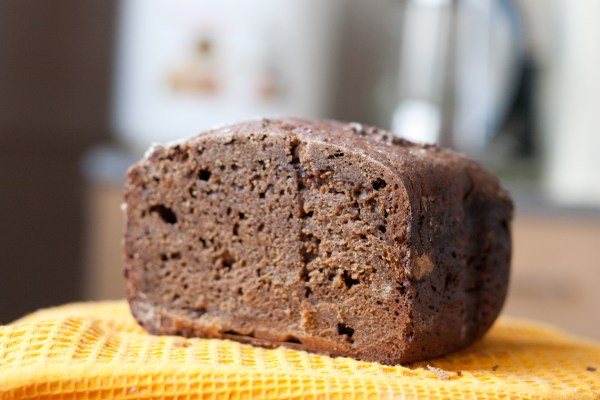
Eating white bread can be harmful, causing constipation, excess weight gain, and a feeling of heaviness in the intestines. If such problems arise, it is advisable to switch to products made from dark flour, especially Borodino bread, consuming about 3-4 slices per day. Larger amounts can cause harm by causing poor fluid removal, especially water from the uterus, thereby complicating labor.
Recommended reading: What are the benefits of pig ears and how to cook them
Compliance with the daily norm will give the expectant mother energy without harm to the fetus and normalize peristalsis. After giving birth, portions of dishes using dark flour can be safely doubled, including them in the diet from the first day, after first finding out the child’s reaction to the new product.
Advice! Women after childbirth often complain about the formation of cellulite. The beneficial properties of rye products help maintain smoothness and firmness of the skin.
The benefits and harms of whole grain rye flour
Unlike peeled flour, whole grain flour uses grains with completely preserved seed coats, which, on the one hand, makes it coarser, but also increases its nutritional value due to its greater saturation with amino acids.
Whole grain rye flour is recommended for nutrition of athletes. It saturates well, but does not disrupt the process of insulin production and provides a large supply of vital energy. Including it in the diet has a positive effect on:
- urinary system - the risk of stone formation is reduced, excess fluid is removed;
- cardiovascular system - “bad” cholesterol is removed, blood clotting is normalized;
- endocrine system - the production of sex hormones is leveled, surges in adrenaline production in negative emotional situations are prevented.
Read: Benefits of hot water with lemon
It is this rough flour that is capable of protecting the body at the cellular level from free radicals - defective molecules with a missing electron, which they strive to snatch from full-fledged molecules.
It is not recommended to indulge in whole grain rye flour if you are prone to flatulence.
Baked goods made from rye flour for children

Experts have different opinions regarding the age when a child can try rye products without harm. Some insist on 3 years of age, others argue that after consultation with a pediatrician or doctor, starting from 1 year old, the baby can be periodically given about 30–40 g of baked goods.
To create it you need to use only high-quality raw materials. And also remember: freshly baked bread is definitely considered harmful due to fermentation in the stomach, especially when combined with fish, jam, and meat. If there is no other choice, a portion of bread designed for a child should become a little stale after standing for 2-3 days.
Types of rye flour
It is customary to distinguish three types of rye flour, which differ in the degree of grinding, yield and content of bran particles:
- sifted rye flour;
- peeled rye flour;
- rye wallpaper flour.
Depending on the content of bran particles, the color of rye flour also differs - the fewer there are, the lighter the product. The low calorie content of rye flour, as well as a large amount of vitamins and minerals, make finished products made from it tasty and healthy. Regardless of the type of rye flour, its main purpose is to bake table breads.
Is rye flour good for diabetes and cholecystitis?
Rye flour is useful for diabetes and cholecystitis, but the use of products made from it is associated with some restrictions. Considering the properties of the product, the benefits and harm that they can cause to the body, the permissible dose for patients with diabetes is limited to 300–350 g, and then only due to long-term carbohydrates.
Consumption for cholecystitis is limited to the period of remission and the daily allowance of 150 g. Bread and pastries should be slightly stale. The same norm is prescribed for patients suffering from low acidity.
Rye flour or wheat flour – which is better and healthier?
Rye flour is useful for diabetes and cholecystitis, but the use of products made from it is associated with some restrictions. Considering the properties of the product, the benefits and harm that they can cause to the body, the permissible dose for patients with diabetes is limited to 300–350 g, and then only due to long-term carbohydrates.
Consumption for cholecystitis is limited to the period of remission and the daily allowance of 150 g. Bread and pastries should be slightly stale. The same norm is prescribed for patients suffering from low acidity.
In terms of its properties, composition and benefits for the body, rye flour is significantly ahead of its wheat counterpart. The rye product has a low glycemic index, contains a large amount of enzymes that break down starch compounds, and also produces a small amount of gluten, minimizing harm to health.
It is worth emphasizing that during kneading the dough, only sourdough is used, and not traditional yeast, this makes the product healthy and allows you to include it in the diet.
- Rye flour has much higher concentrations of free proline, an essential amino acid for creating proteins, than the wheat variety. Additionally, this concentration also differed from wheat as it showed a much lower increase in acrylamide, which is a chemical compound linked to the formation of cancer cells in starchy foods such as potatoes and wheat products.
- Although wheat bread typically contains more protein (6 grams in two slices) compared to rye bread (5.4 grams in two slices), rye bread has more fiber: 3.7 grams. versus 2.4 g. in two slices of bread.
- Wheat promotes a higher insulin response in the body compared to rye, so the body tends to consume more fat when wheat is consumed regularly than rye.
- Bread made from rye flour contains more soluble fiber than wheat, sometimes three times more than white wheat bread.
- Rye and rye bran have one of the highest concentrations of lignans compared to wheat and other grains.
- Rye bread contains 20% fewer calories than white wheat bread.
Medicinal products based on rye flour
Raw rye is recognized not only as a food product, it is a natural medicine that helps in the treatment of the most common diseases.

For high blood pressure
The most effective remedy to help people at stages 2 and 3 of hypertension is to consume on an empty stomach a spoonful of coarse rye flour, previously filled with hot water. If you have permission from your attending physician, the beneficial properties of the product can be enhanced by taking laxatives at the same time.
For chronic colds
The substance is useful for chronic runny nose. Treatment with rye flour cakes will help get rid of an unpleasant illness:
- take some flour, grated horseradish and honey;
- mix thoroughly to make an elastic dough;
- roll out the flatbread to medium thickness;
- place on the bridge of the nose and hold for 15–20 minutes.
Repeat the procedure daily for 7–10 days, always mixing a fresh portion.
Important! During this time, the illness should go away; if not, a second visit to the doctor is necessary.
Compress for lymphostasis

Problems with the outflow of fluids in the legs cause a lot of inconvenience and discomfort. A special compress will help improve the situation, for the preparation of which you need to prepare 250–300 g of rye raw material, brewed with boiling water.
- The mass is mixed and left to cool completely.
- Then kefir is added to the compress, everything is again brought to a homogeneous state.
- The mixture is spread on a napkin of natural fabric or bandage, which is placed on the swollen area and wrapped with waterproof film.
- The procedures are carried out daily in the morning and evening until the swelling disappears. The holding time of one compress is about 2 hours.
Compress for radiculitis
The properties of rye help get rid of radiculitis or, in difficult cases, alleviate symptoms.
To prepare the compress you need to take:
- 2.5 liters of heated water;
- a spoonful of sugar;
- 10 g yeast;
- 500 g flour.
Preparation:
- The ingredients are poured into a hermetically sealed container, shaken well and infused for 5 days.
- Before use, a cloth is soaked in the mixture and placed on the sore spot.
- The compress is kept for 30 minutes, after removing it you need to lie down for the same amount of time.
- The procedure is repeated once a day for 10 days.
The benefits and harms of peeled rye flour
The unique benefits of the product are explained by the fact that 90% of it consists of endosperm - a layer of cereal cells surrounding the germ of the grain. The remaining 10% comes from the outer layers of the grain shell. If we analyze the composition of the peeled product in comparison with other varieties of rye flour, it will turn out to be much richer in starch and somewhat poorer in protein.
Science notes the high bioavailability of peeled rye flour:
- calcium - strengthens bone tissue;
- vitamin B9 - promotes the “flourishing” of reproductive health;
- iodine - heals the thyroid gland;
- vitamin E - improves the condition of the skin;
- molybdenum - sharpens twilight vision.
Read: Health benefits and harms of dates
It is useful to eat products made from such flour to speed up digestion and regularly remove toxins and carcinogens from the body.
Surprisingly, it is peeled rye flour that can “take care” of the nervous system no worse than chocolate, improving mood and protecting against stress.
Products made from peeled rye flour are completely excluded from the diet in case of chronic pancreatitis (no matter - in the acute stage or remission), as well as in case of gastric erosion.
Rye flour in home cosmetology
The substance is a recognized cosmetic aid that can improve the condition of hair and facial skin in a short time. Using the valuable properties of the product, the benefits and lack of harm in this area, masks, shampoos, and compresses are created from it.

Face masks
A harmful external environment, frequent stress, and poor quality nutrition inevitably affect the condition of facial skin. Age-related changes do not add beauty, which are becoming increasingly difficult to combat. The help of rye raw materials on this front is difficult to overestimate, since the benefits of its use are enormous.
Thanks to him he manages to:
- gently cleanse pores;
- tone the skin;
- achieve harmless whitening;
- relieve irritation.
We recommend reading: The benefits and harms of ginger for the health of men and women
Rye flour has regenerating properties, neutralizes inflammatory processes, removes age spots, smooths out small wrinkles, and evens out color.
The simplest option is to mix flour and water or milk until creamy and apply it to a cleansed face. A mask made from a mixture of rye flour, chamomile essential oil, primrose, vitamin A and a drop of honey is also universal.
To nourish the epidermis, you need to mix the main product with sour cream, and a mixture of aloe juice and milk will help relieve inflammation.
If there is a need for pre-peeling, rye flour can be mixed with a small amount of boiled ground coffee and cherry juice.
Advice! Even in advanced cases, it is advisable to keep the mask on for no more than 15–20 minutes. It is not advisable to repeat the procedure more than 2-3 times a week. Too frequent cosmetic procedures cause just as much harm as not having enough of them.
Shampoos made from rye flour for washing hair
Systematic use of rye flour shampoo allows you to:
- normalize the secretions of the sebaceous glands;
- effectively combat hair loss;
- quickly get rid of dandruff;
- make hair more manageable.
Homemade shampoo for oily hair consists of the following ingredients:
- a little essential oil;
- 100 ml milk;
- 50 g rye flour.
The mixture is applied 2 times, then completely washed off without the use of chemicals. Blondes whose hair shade is slightly yellow should add a little lemon juice and honey to the main mixture.
Important! Rye flour is also used instead of dry shampoo if it is not possible to wash your hair properly. The product is rubbed in and then combed out.

Mask for brittle and thin hair
The positive nutritional properties of rye flour are perfectly complemented by egg yolk, which contains at least 200 useful substances. The prepared mask will strengthen hair follicles, stop hair loss, and stimulate growth. If there is no negative reaction to alcohol-containing masks, add a spoonful of cognac to the mixture.
A hair mask made from rye flour is applied to dirty hair and rubbed into the scalp. After 10–20 minutes. it can be washed off. It is normal if after the first use a little dandruff appears, this is how the skin is cleansed of dead cells and chemical residues. The use of a folk remedy without causing harm is limited to 1–2 procedures per 10 days.
Rye flour in cooking
Dough made from rye flour is inelastic, inelastic, and sticks to your hands, since such flour contains very little gluten. Therefore, when preparing at home, it is better to mix it with wheat in equal proportions. This bread can be stored 2 times longer than wheat bread. Rye flour can also be used to make muffins, cookies and scones.
From this flour you can prepare a starter for kvass. This drink retains all the vitamins and minerals contained in rye grains. Kvass improves metabolism. It helps patients with diabetes.
Each type of flour is used for specific bakery products:
- peeled is used for baking bread cakes, preparing batter, and added to other types of flour;
- from peklevanny flour you can make sourdough, pan, hearth, wheat-rye bread;
- sifted is used to prepare sweet and sour, custard bread;
- coarse grinding is used for making loaves, hearth and custard breads.
This bread goes well with vegetables, soups, and dairy products.
Rye flour can absorb odors, so it should be stored away from foods with strong aroma.
Which is healthier: rye or wheat flour?

In terms of its properties, composition and benefits for the body, rye flour is significantly ahead of its wheat counterpart. The rye product has a low glycemic index, contains a large amount of enzymes that break down starch compounds, and also produces a small amount of gluten, minimizing harm to health.
It is worth emphasizing that during kneading the dough, only sourdough is used, and not traditional yeast, this makes the product healthy and allows you to include it in the diet.
Wheat or rye
Compared to wheat flour, rye flour contains more active enzymes that break down starch compounds. This explains the low glycemic index value. In addition, it is less prone to gluten formation. Thanks to these properties, rye flour is one of the most useful products for baking, along with oatmeal, rice and buckwheat.
The product has a high level of autolytic activity, which is responsible for the content of water-soluble substances in the test. For sifted and peeled flour this figure is no more than 50%, for wallpaper – 55%.
The main disadvantage is that rye dough has less elasticity, which is why the finished bread often loses its shape when cut. Whereas products made from wheat flour, especially the highest grade, are distinguished by a more airy consistency and increased elasticity.
When baking rye baked goods, sourdough is used, not yeast, as when kneading wheat dough. Therefore, they are suitable for dietary intake.
| Wheat | Rye | |
| Calorie content, kcal | 340 | 325 |
| Protein, g | 13 | 16 |
| Alimentary fiber | 11 | 24 |
| Calcium,% | 3 | 4 |
| Iron, % | 20 | 28 |
| Vitamins | ||
| A, ME | 9 | 11 |
| E, mg | 0,71 | 2,73 |
| K, mg | 1,9 | 5,9 |
| B2, mg | 0,16 | 0,25 |
| B5, mg | 0,6 | 1,45 |
| B6, mg | 0,4 | 0,44 |
| Mineral components | ||
| Magnesium, mg | 137 | 160 |
| Phosphorus, mg | 357 | 499 |
| Potassium, mg | 363 | 717 |
| Zinc, mg | 2,6 | 5,0 |
| Copper, mg | 0,41 | 0,56 |
| Manganese, mg | 4 | 6 |
| Selenium, mcg | 61,8 | 18 |
Buckwheat flour - composition and calorie content.
How to cook and serve
In industrial cooking, peeled rye flour is used mainly for baking bakery products and bread itself.
This type of rye flour is characterized by a reduced content of protein, which forms gluten, so working with such dough is somewhat difficult.
It turns out very sticky and heavy. To solve the problem in home cooking, housewives mix peeled rye flour with wheat flour. In this case, the finished products have a pleasant aroma and interesting taste, and also benefit human health and remain fresh for a long time.
Composition and calorie content
The basis of the composition is proteins and carbohydrates, which provide the human body with energy and building material. The general composition of rye flour (100g) is as follows:
- 8.9 g protein;
- 61.8 g carbohydrates;
- 1.7 g fat.
The total calorie content of rye flour is 298 kcal per 100 grams of product.
Rye flour also contains minerals necessary for the body:
- calcium, which is involved in the construction and support of the skeleton and the functioning of the nervous system;
- potassium, necessary for normal transmission of nerve impulses;
- iron and magnesium, which contribute to normal hematopoiesis;
- phosphorus, which ensures healthy bones and cartilage and many other micro- and macroelements.
All of them are preserved in the final flour products. In addition to minerals, the chemical composition of rye flour includes vitamins B and E.
Thiamine (vitamin B1) supports metabolism and the health of the nervous system, and its deficiency can lead to myocardial problems and other unpleasant consequences.
Vitamin B2 supports thyroid function and reproductive function, while folic acid (B9) is essential for body growth and to prevent anemia.
In general, in conditions of lack of sun and heat (for example, in the northern regions), rye bread and other baked goods made from rye flour are vital for good health.
Rye bread is also useful for those suffering from anemia or metabolic disorders. At the same time, despite all the beneficial properties, it is undesirable to use products made from rye flour if you have a peptic ulcer or high stomach acidity. With such diseases there will be more harm than good, the pathological condition of the body will worsen.
Benefit
The benefits of peeled rye flour for the human body have been proven by many doctors and nutritionists:
- regular consumption of products based on peeled rye flour has a beneficial effect on attempts to conceive and bear a child;
- Peeled flour in a variety of baked goods, due to the presence of fiber, can normalize the functioning of the gastrointestinal tract;
- the content of linolenic acid, which is absent in wheat flour, is beneficial for our cardiovascular system and hematopoiesis;
- peeled rye flour removes waste, toxins and salts from the body, reduces harmful cholesterol;
- prevents the development of diabetes and helps prevent cancer.
Among other things, black bread made from such flour strengthens the immune system, protects the body from aging, improves mood and overall tone, and makes it possible to cope with depression and nervousness.
Interesting: Compared to the widespread wheat flour, peeled rye flour contains a record amount of B vitamins.


